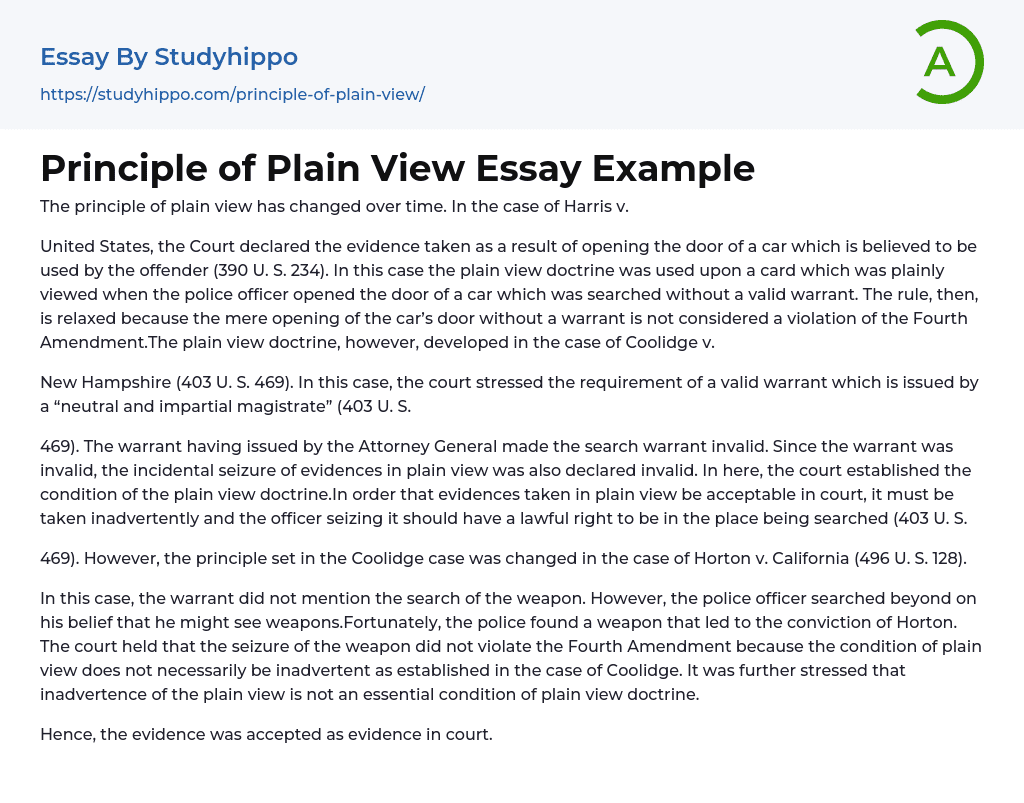Over the years, the concept of plain view has undergone changes as observed in Harris v.
The case of 390 U.S. 234 saw the United States Court rule that evidence obtained by opening a car door believed to be used in a crime was admissible, applying the plain view doctrine as a police officer saw an item in clear sight upon doing so without a warrant. This action does not violate the Fourth Amendment and is thus permissible under relaxed rules. The Coolidge v. case further confirmed this doctrine.
The importance of a warrant that is valid and issued by an unbiased magistrate was highlighted in the case of New Hampshire (403 U.S. 469).
As a result of being issued by the Attorney General, the search warrant was deemed invalid and any incidental evidence found in plain view is also invalid. The court establi
...shed guidelines for the plain view doctrine: the officer must have obtained the evidence unintentionally and have legal authorization to be in the searched area (403 U.S. 469).
The principle established in the Coolidge case (469) underwent a modification in the case of Horton v. California (496 U. S. 128).
Despite the lack of authorization for a weapon search in the warrant, a police officer proceeded to carry out one. This led to Horton's conviction after a weapon was found. The court declared this search acceptable under the Fourth Amendment, drawing on Coolidge's earlier decision that plain view searches do not have to occur by chance. Furthermore, the court emphasized that inadvertence is not a requirement for invoking the plain view doctrine.
The court determined that the evidence was admissible
- Federal government essays
- Armed Forces essays
- Confederate States Of America essays
- Federal Government Of The United States essays
- Fourteenth Amendment To The United States Constitution essays
- Governance essays
- Parliament essays
- Politics essays
- Jurisdiction essays
- Bureaucracy essays
- Separation Of Powers essays
- Congress essays
- President essays
- United States Congress essays
- Non-Commissioned Officer essays
- Appeal essays
- Revenge essays
- Corporate Governance essays
- Public Service essays
- Income Tax essays
- Supply essays
- Red Cross essays
- Democracy essays
- State essays
- Liberty essays
- Absolutism essays
- Reform essays
- Republic essays
- John Marshall essays
- Bourgeoisie essays
- Developed Country essays
- Elections essays
- International Relations essays
- Left-Wing Politics essays
- Monarchy essays
- Political Corruption essays
- Political Party essays
- Political Science essays
- Sovereign State essays
- United Nations essays
- World Trade Organization essays
- Contras essays
- Dictatorship essays
- Foreign policy essays
- Monarch essays
- Corruption essays
- Foreign essays
- Democratic Party essays
- European Union essays
- President Of The United States essays




